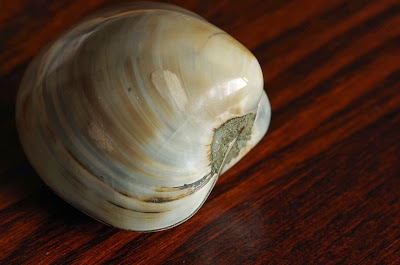When I was at a conference this past December, I bought a fossilized clam.
I didn’t expect to. In fact, at first I had made fun of the excess of minerals and fossils offered (very cannily) by the booth exhibitors to conference attendees, even going so far as to say, “I started out being intrigued, but then I thought, wait a second—who needs a fossil clam?”
I do. I need a fossil clam.
I won’t go into further detail (though I could—oh, I could) about how great this clam is. However, I will say that the clam came with no information, so I don’t know what period it’s from, what species it is, or where it was found.
That’s not surprising, though, is it? After all, clams are notorious for keeping their secrets—clamming up, let us say. It’s hard to pry the succulent flesh of their histories out of them.
There are some very cool things worth knowing about clams and other bivalves, though. One of the most surprising is just how long-lived they are.
You’ve probably noticed the lines and ridges that make up the shells of clams, mussels, oysters, and other bivalves. It turns out that, by examining cross-sections of shells and looking at repeated patterns of thick-and-thin lines, researchers can determine how old the animals are.
[umbo (beak-y part) of a surf clam, Spisula solidissima]
That is to say, how old the animals
were—since you have to kill them to use the technique. But that’s the price you pay for knowledge!
It turns out that many of the clams we’re used to seeing or eating—like the quahogs (
Mercenaria mercenaria) that make up clam chowder, or the soft-shelled clams (
Mya arenaria) we eat as “steamers”—are pretty damn old: steamer clams live about 8-12 years and
can live as many as 23, while quahogs often live into their 40s—and some have been found to live
over 100 years. Even these, though, aren’t the real Methuselahs of mollusks—that title is reserved for the Icelandic clam (
Arctica islandica): the oldest recorded clam of this species
was 507 years old.
[thee clams were cut off in their youth, long before they reached their maximum age, by a predatory snail]
Compare this to the average age of most cephalopods [octopi, squid, cuttlefish], who don’t live more than three or four years, and you have yet more evidence that brains aren’t everything.
And thus concludes my first disquisition on bivalves. Will it be the last? Hard to say. I didn’t think I had a lot to say about them—but then, I used to think I didn’t need a fossil clam…











